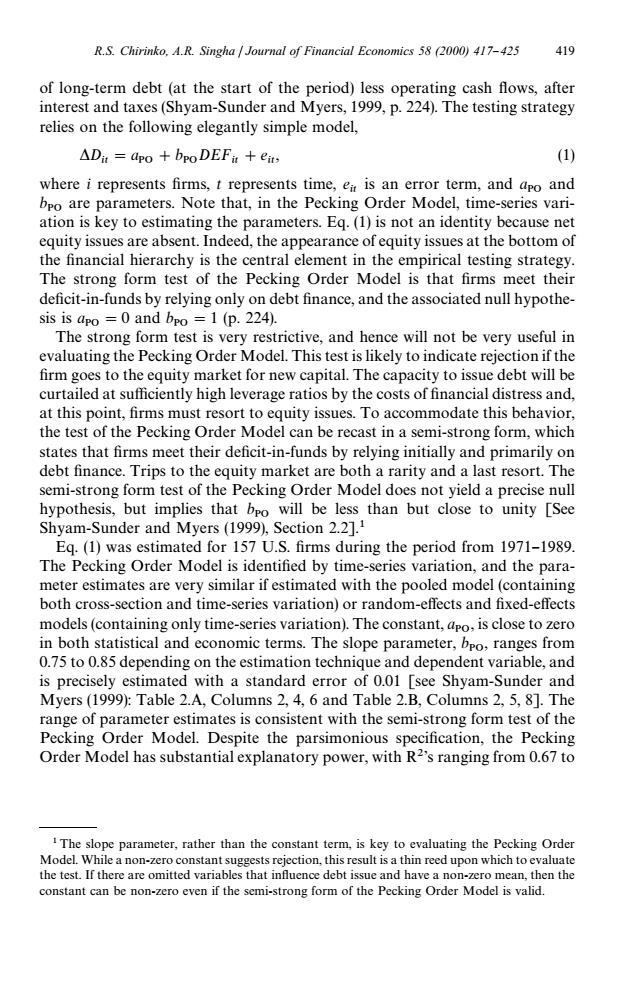正在加载图片...

R.S.Chirinko.A.R.Singha Journal of Financial Economics 58 (2000)417-425 419 of long-term debt(at the start of the period)less operating cash flows,after interest and taxes(Shyam-Sunder and Myers,1999,p.224).The testing strategy relies on the following elegantly simple model, △Da=po+bpo DEFit+er, (1) where i represents firms,t represents time,eir is an error term,and apo and bpo are parameters.Note that,in the Pecking Order Model,time-series vari- ation is key to estimating the parameters.Eq.(1)is not an identity because net equity issues are absent.Indeed,the appearance of equity issues at the bottom of the financial hierarchy is the central element in the empirical testing strategy. The strong form test of the Pecking Order Model is that firms meet their deficit-in-funds by relying only on debt finance,and the associated null hypothe- sis is apo =0 and bpo =1 (p.224). The strong form test is very restrictive,and hence will not be very useful in evaluating the Pecking Order Model.This test is likely to indicate rejection if the firm goes to the equity market for new capital.The capacity to issue debt will be curtailed at sufficiently high leverage ratios by the costs of financial distress and, at this point,firms must resort to equity issues.To accommodate this behavior, the test of the Pecking Order Model can be recast in a semi-strong form,which states that firms meet their deficit-in-funds by relying initially and primarily on debt finance.Trips to the equity market are both a rarity and a last resort.The semi-strong form test of the Pecking Order Model does not yield a precise null hypothesis,but implies that bpo will be less than but close to unity [See Shyam-Sunder and Myers (1999),Section 2.2].1 Eq.(1)was estimated for 157 U.S.firms during the period from 1971-1989 The Pecking Order Model is identified by time-series variation,and the para- meter estimates are very similar if estimated with the pooled model(containing both cross-section and time-series variation)or random-effects and fixed-effects models(containing only time-series variation).The constant,apo,is close to zero in both statistical and economic terms.The slope parameter,bpo,ranges from 0.75 to 0.85 depending on the estimation technique and dependent variable,and is precisely estimated with a standard error of 0.01 [see Shyam-Sunder and Myers (1999):Table 2.A,Columns 2,4,6 and Table 2.B,Columns 2,5,81.The range of parameter estimates is consistent with the semi-strong form test of the Pecking Order Model.Despite the parsimonious specification,the Pecking Order Model has substantial explanatory power,with R2's ranging from 0.67 to The slope parameter,rather than the constant term,is key to evaluating the Pecking Order Model.While a non-zero constant suggests rejection,this result is a thin reed upon which to evaluate the test.If there are omitted variables that influence debt issue and have a non-zero mean,then the constant can be non-zero even if the semi-strong form of the Pecking Order Model is valid.1The slope parameter, rather than the constant term, is key to evaluating the Pecking Order Model. While a non-zero constant suggests rejection, this result is a thin reed upon which to evaluate the test. If there are omitted variables that in#uence debt issue and have a non-zero mean, then the constant can be non-zero even if the semi-strong form of the Pecking Order Model is valid. of long-term debt (at the start of the period) less operating cash #ows, after interest and taxes (Shyam-Sunder and Myers, 1999, p. 224). The testing strategy relies on the following elegantly simple model, *Dit"a PO#b PODEFit#e it, (1) where i represents "rms, t represents time, e it is an error term, and a PO and b PO are parameters. Note that, in the Pecking Order Model, time-series variation is key to estimating the parameters. Eq. (1) is not an identity because net equity issues are absent. Indeed, the appearance of equity issues at the bottom of the "nancial hierarchy is the central element in the empirical testing strategy. The strong form test of the Pecking Order Model is that "rms meet their de"cit-in-funds by relying only on debt "nance, and the associated null hypothesis is a PO"0 and b PO"1 (p. 224). The strong form test is very restrictive, and hence will not be very useful in evaluating the Pecking Order Model. This test is likely to indicate rejection if the "rm goes to the equity market for new capital. The capacity to issue debt will be curtailed at su$ciently high leverage ratios by the costs of "nancial distress and, at this point, "rms must resort to equity issues. To accommodate this behavior, the test of the Pecking Order Model can be recast in a semi-strong form, which states that "rms meet their de"cit-in-funds by relying initially and primarily on debt "nance. Trips to the equity market are both a rarity and a last resort. The semi-strong form test of the Pecking Order Model does not yield a precise null hypothesis, but implies that b PO will be less than but close to unity [See Shyam-Sunder and Myers (1999), Section 2.2].1 Eq. (1) was estimated for 157 U.S. "rms during the period from 1971}1989. The Pecking Order Model is identi"ed by time-series variation, and the parameter estimates are very similar if estimated with the pooled model (containing both cross-section and time-series variation) or random-e!ects and "xed-e!ects models (containing only time-series variation). The constant, a PO, is close to zero in both statistical and economic terms. The slope parameter, b PO, ranges from 0.75 to 0.85 depending on the estimation technique and dependent variable, and is precisely estimated with a standard error of 0.01 [see Shyam-Sunder and Myers (1999): Table 2.A, Columns 2, 4, 6 and Table 2.B, Columns 2, 5, 8]. The range of parameter estimates is consistent with the semi-strong form test of the Pecking Order Model. Despite the parsimonious speci"cation, the Pecking Order Model has substantial explanatory power, with R2's ranging from 0.67 to R.S. Chirinko, A.R. Singha / Journal of Financial Economics 58 (2000) 417}425 419